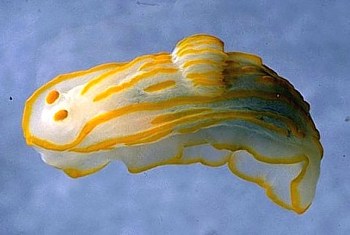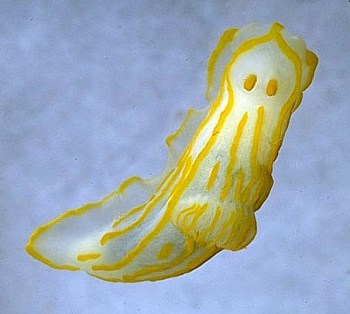

Gymnodoris striata
(Eliot, 1908)
Order: NUDIBRANCHIA
Suborder: DORIDINA
Superfamily: ANADORIDOIDEA
Family: Gymnodorididae
DISTRIBUTION
Indo-West Pacific, from Red Sea to Japan.
PHOTO
23mm long, Broadhurst Reef, Townsville, Queensland, May 1974. PHOTOS: Ian Loch.
RELATED TOPIC
Widespread Indo-West Pacific species, which is reported to grow to 55mm in length (Johnson & Boucher, 1983). It is characterised by the longitudinal orange lines on the dorsum and the tranverse arrangement of the gills. There is considerable variability in the orange ridges on the body. Animals lacking most of the orange ridging were considered a separate species, Gymnodoris amakusana by Baba recently, but I can find no anatomical differences. Risbec (1928) considered the arrangement of the gills to be sufficient grounds for erecting a new genus Analogium for this species, but this is not followed by most authors, although it is used by Hamatani (1995) and Baba (1996).
References:
•Rudman, W.B., Darvell, B.W. (1990). Opisthobranch Molluscs of Hong Kong: Part 1. Nudibranch Families; Goniodorididae, Onchidorididae, Triophidae, Gymnodorididae, Chromodorididae. Asian Marine Biology, 7: 31-79.
•Hamatani, I. (1995) A new record on Analogium striatum (Eliot, 1908) (Opisthobranchia: Nudibranchia: Gymnodorididae) from southwestern Japan. Venus, (Japanese Journal of Malacology), 54(3): 179-183.
•Baba, K. (1996) Taxonomical change for Gymnodoris striata of Baba, 1937 (Nudibranchia: Gymnodorididae) from Amakusana, with a re-description based on some additional specimens from Toyama Bay, Japan. Venus, (Japanese Journal of Malacology), 55(2): 91-95.
Rudman, W.B., 1999 (September 24) Gymnodoris striata (Eliot, 1908). [In] Sea Slug Forum. Australian Museum, Sydney. Available from http://www.seaslugforum.net/find/gymnstri
Related messages
Gymnodoris striata from Thailand.
May 26, 2009
From: Vie Panyarachun

Concerning message #13528:
Just thought you might like a record of Gymnodoris striata from SE Asia.
Locality: Ko Tachai, Similan Islands National Park, 12 msw, Thailand, Andaman Sea, 21 February 2009, Sandy bottom, area of broken coral.. Length: approx. 1.25 inches. Photographer: Vie Panyarachun.
Vie
vpanyarachun@hotmail.com
Panyarachun, V., 2009 (May 26) Gymnodoris striata from Thailand.. [Message in] Sea Slug Forum. Australian Museum, Sydney. Available from http://www.seaslugforum.net/find/22284
Thanks Vie,
Best wishes,
Bill Rudman
Gymnodoris striata from the Solomon Ids
April 21, 2005
From: Bruce Potter


Dear Bill,
Another of my recent finds in Honiara was this Gymnodoris striata. This was at about 12 meters on a coral and rubble site on the outskirts of Honiara, Solomon Islands. It was about 30mm long.
Locality: Honiara, Solomon Islands. Depth: 12 meters. Length: 30 mm. 6 January 2005. Coral, Rubble, Sand. Photographer: Bruce Potter
Regards
Bruce.
bandppotter@bigpond.com.au
Potter, B., 2005 (Apr 21) Gymnodoris striata from the Solomon Ids. [Message in] Sea Slug Forum. Australian Museum, Sydney. Available from http://www.seaslugforum.net/find/13528Thanks Bruce,
Bill Rudman
Gymnodoris striata from Egypt
October 1, 2002
From: Michael Mrutzek

Dear Bill,
Here is a photo of another slug from the Red Sea for use in the Forum.
Data: Inside Disha Reef, 6 meters, off Hurghada, on the Red Sea coast of Egypt, August, 2002. Photo: Copyright Michael Mrutzek.
Michael
Mrutzek@meeresaquaristik.de
Mrutzek, M., 2002 (Oct 1) Gymnodoris striata from Egypt. [Message in] Sea Slug Forum. Australian Museum, Sydney. Available from http://www.seaslugforum.net/find/8032Thanks Michael,
This is Gymnodoris striata, a nudibranch that hunts down and eats other sea slugs.
Best wishes,
Bill Rudman
Gymnodoris striata from Saudi Arabia
April 4, 2001
From: Larry Dupriest


This photo was taken in the summer of 2000 along the Red Sea shoreline about 100 km north of Yanbu, Saudi Arabia (near the Yanbu Cement Plant). This is an area where the coral reef parallels the shore about 75 feet [25m] out. The reef is a vertical 50 foot drop [17m] of live coral teaming with fish varieties. These nudi's were found in the 2-3 feet deep [1m] shallows about half way out to the reef.
Larry Dupriest
dgdupriest@gtis.net
Dupriest, L., 2001 (Apr 4) Gymnodoris striata from Saudi Arabia. [Message in] Sea Slug Forum. Australian Museum, Sydney. Available from http://www.seaslugforum.net/find/4099Dear Larry,
Thanks for the nice photo of Gymnodoris striata. Although all nudibranchs are carnivores, only a few families, like the gymnodorids are true hunters, feeding on active prey. Gymnodorids feed on other sea slugs. If you have a look at some of the other mssages on this page you will see that this species seems to prefer the sand-dwelling sacoglossan Plakobranchus ocellatus.
Your photo also shows the very distinctive gills very distinctly. They form a curved transverse row of plates across the body, rather than the more typical circlet found in most species.
Best wishes,
Bill Rudman
Gymnodoris striata from Red Sea
September 26, 1999
From: Erwin Koehler

Bill,
Here is Gymnodoris striata (Eliot, 1908) from the Red Sea.
Location: Sharm El Sheikh, Red Sea, divesite "Laguna Nord", size ~ 3 cm, depth 3 m, nightdive, Sept. 12, 1997
Erwin
Medslugs.Koehler@t-online.de
Koehler, E., 1999 (Sep 26) Gymnodoris striata from Red Sea. [Message in] Sea Slug Forum. Australian Museum, Sydney. Available from http://www.seaslugforum.net/find/1297Thanks Erwin,
It looks like specimens I have seen from the Red Sea. If you have any photos showing any colour variation, from anywhere, I would be interested in seeing them.
Bill Rudman.
Observations on Gymnodoris striata
September 25, 1999
From: Scott Johnson


Hi Bill,
Although I haven't seen any here at Kwajalein for some years now, Gymnodoris striata used to show up periodically at Enewetak Atoll, Marshall Islands. They tended to be on sand and Halimeda algae along lagoon interisland reefs at depths of about 5 to 20 meters. They were not always present, but if I found any at all I'd generally find a bunch, often 10 or more in the same area. I'm not sure where they were coming from or why they would appear all of a sudden. It probably wasn't food, since they liked to eat Plakobranchus ocellatus, which is typically present all the time.
The lower photo shows an animal laying its typical cylindrical egg ribbon.
[See Scott's description and photos of Gymnodoris striata feeding, which I have posted separately - Bill Rudman].
Johnson, S., 1999 (Sep 25) Observations on Gymnodoris striata. [Message in] Sea Slug Forum. Australian Museum, Sydney. Available from http://www.seaslugforum.net/find/1320Feeding behaviour in Gymnodoris striata
September 25, 1999
From: Scott Johnson

Hi Bill,
Continuing the story of Gymnodoris striata at Enewetak Atoll, Marshall Islands.
As I said, they liked to eat Plakobranchus ocellatus, which is typically present all the time. These four pictures show a couple of different Gymnodoris individuals eating Plakobranchus; the predator's body often contracted while consuming its prey.
Scott
johnson@kmr.ll.mit.edu


Dear Scott,
Thanks for the photos. Can I assume from Johnson & Boucher (1983), that these Gymnodoris were about 50mm long? which would make the Plakobranchus about 20mm. I have posted some material on G. striata and 'G. amakusana', suggesting they may be colour forms of each other. There seems to be a bit of colour variability in the photos you have sent. If you have some photos showing a range in colour variability, they would be very welcome.
Best wishes,
Bill Rudman.
